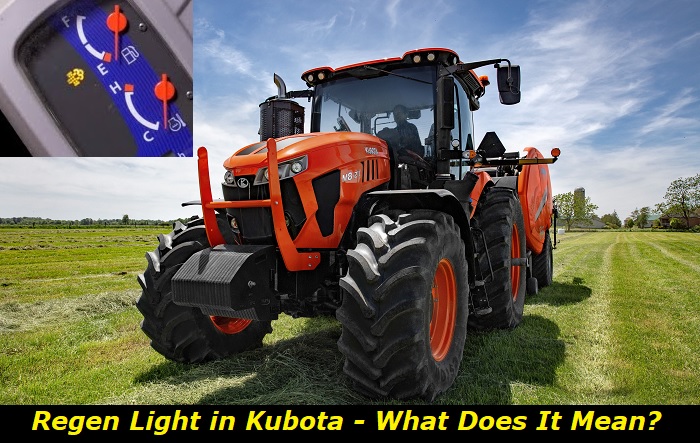Kubota Regeneration Light – Why Is it On? And What to Do?
What is regeneration? Is it a must that it must be performed in a Kubota tractor? How does one know that regeneration is required and how long does it last? How many times is regeneration done in the life of a Kubota tractor?
In this article, we shall answer all these questions and provide all other details relating to Kubota engine regeneration and how to correctly perform it whenever required.

What is regeneration?
Regeneration is a process of restoring the optimum capacity of the DPF by cleaning and emptying the filter by burning the solid trapped particles. To understand the regeneration process, one must know a thing or two about the DPF.
DPF
DPF stands for Diesel Particulate Filter. It is a device that is fitted into the exhaust system to trap particulate matter and reduce harmful emissions into the atmosphere. The DPF is fitted in diesel engines to trap soot and other matter found in exhaust gases. It is fitted in these engines as part of the global environmental campaigns to reduce the impact of exhaust emissions. Moreover, controlling emissions is part of the motoring standards required by law in different countries.
The particulate matter (soot) collects in the filter and must be regularly removed to enable the filter to continue performing its intended purpose at optimum levels. The process of removing the particulate matter to clean the filter is called regeneration.
How Regeneration is done?
The process of internal combustion releases volumes of gases and another particulate (solid) matter (PM), also called soot. It forms due to the incomplete combustion of diesel at high temperatures in the combustion chamber. The PM accounts for between 50% and 80% of all particles emitted by the engine. The soot is then trapped by the DPF and with time, it accumulates in the filter and has to be removed to retain the filter capacity through regeneration.
The process of regeneration involves heating the DPF at very high temperatures to burn the PM and turn it into carbon dioxide gas which is then safely emitted into the atmosphere. This is a thermal process that oxidizes solid PM into a gas, mostly carbon dioxide. This oxidation process occurs through a reaction with nitrogen dioxide or atmospheric oxygen.
Atmospheric oxygen is readily available at the exhaust point in sufficient concentrations. Active/auto regeneration uses oxygen at high temperatures to achieve DPF regeneration. On the other hand use of nitrogen dioxide requires low temperatures but requires a catalyst to enable regeneration to continue.
This process releases space for the filter to continue trapping more soot from the engine and ensure the engine continues to perform optimally.
There are two main regeneration processes that an operator can perform for the Kubota tractor- active or passive/manual. Should the two fail to achieve the intended results, one can still perform a forced regeneration, though its success is dependent on many other factors.
DPF in a Kubota tractor
The DPF in a Kubota tractor is responsible for the seemingly 'no smoke' seen coming from the exhaust pipe. Gone are the days when black smoke billowing upwards was the key locater of a tractor in the field.
Apart from emitting clean exhaust gases, the DPF is responsible for other critical benefits of the Kubota tractor which include:
- Full engine/operational power with minimal environmental pollution.
- Improved fuel efficiency.
- Reduced engine noise.
- Increased engine power output
- Minimal gas emissions.
How do I know when to perform a DPF regeneration?
When the DPF becomes clogged with the PM, or when the filter has a build-up of soot and is nearly full, the regeneration light (orange in color) on the Kubota dashboard will start to blink and beep continuously. This is a warning that the DPF is clogged and requires regeneration. The light and the beep sound will remain until you initiate one of the two options for the regeneration process. Note that the light may also flash if there is a fault in the DPF system.
The DPF in a Kubota tractor on average requires regeneration after every 15-20 hours of operation. However, the time-lapse may be shorter or longer depending on the operating conditions and demands at different times.
Once the regen light comes on, the operator may press the 'Auto Regen' button or the 'Delay' button on the Kubota.
Auto Regen
This option should be selected if the Kubota is outdoors and in a safe, non-combustible location. Once selected, the DPF will begin to regenerate automatically until the process is over. Though there is little operator input, the following must be retained:
- The engine must continue running at an RPM of 1900-2000. This is to ensure the engine temperature is high enough (around 6000C) to aid in the regeneration.
- The engine should not have extra loads other than running.
- All accessories such as air-con, onboard accessories, and lights must be put off.
- The process, which takes about 20-30 minutes, must not be interrupted until it is over.
Manual Regeneration
The operator may opt to press the 'Delay' button and carry out a manual regeneration later. This option is selected when the operator feels it is not safe to carry out the regeneration process, based on the operating manual. For instance, if the Kubota is indoors, in a shed, or in a combustible area, the regen should be delayed.
Once ready to begin manual regeneration, the operator should do the following:
- Stop and place the Kubota tractor on level ground.
- Put the tractor into neutral gear.
- Apply the tractor parking brake.
- Turn the manual regeneration switch to begin the process (if having a modern Kubota, wait for the 'Parked Regeneration' switch to flash and then press it)
- The regeneration will begin.
- The engine RPM will rev upwards as more fuel is sent to the exhaust system to help generate enough heat to burn the soot.
- During this process do not touch or engage any levers, throttle, or switches. The engine RPM should not be adjusted. The 'Regen' light will remain on throughout the process.
- Note that if any of these interruptions occur, the regeneration process has to be repeated.
- Once the light goes off, the manual regeneration process is over. It is now safe to continue with the Kubota operations.
The regeneration process restores the DPF capabilities to absorb PM and enable the engine to run at optimum levels for efficiency. Apart from engine efficiency and increased output, the DPF is a legal requirement to maintain a standardized minimum threshold of engine emissions.
Regeneration problems
If the regeneration light and beep fail to stop even after the regen is completed, there may be some deeper issues relating to the engine or the DPF.
- Let the engine and the exhaust system cool down since the excess heat build-up may cause the light to remain on.
- Check the error codes to determine whether there is any error that may be affecting the engine after regeneration.
- Carry out a thorough check on all sensors and electrical wiring to ascertain they are in good working condition.
- If the problem persists, consult an expert or a certified Kubota technician for an in-depth diagnosis.
Effects of blocked DPF
- If the DPF becomes clogged or damaged, there are serious repercussions to the engine and the entire tractor.
- The filter may become damaged and must be replaced (it is very expensive to replace the DPF filter).
- It damages and reduces the lifespan of the DPF filter (a DPF should last at least 100,000 miles)
- Reduces fuel efficiency
- Can limit proper exhaust flow and cause issues with the engine.
A Kubota tractor can be regenerated as many times as possible, up to about 3,000 hours. After this point, the DPF may attain an accumulation point that cannot be regenerated normally and requires a special off-machine filter cleaning. The ash accumulation is a result of wear, fuel, and lubricant usage.
If an engine is unable to regenerate the DPF, severe engine damage is likely to occur. Sometimes, the DPF gets clogged to the extent that the regeneration process cannot remove the clog. Clogging is brought about by ash that remains after the regeneration of soot. This ash mixes with oil to form a tough product that sticks in the DPF.
Symptoms of a clogged DPF include increased fuel consumption, visible exhaust fumes, abnormal noises, and high levels of oil in the engine. Since regeneration may not remove the clog, the DPF should be flushed with special equipment, or if that fails, it should be replaced.
Summary
Kubota DPF regeneration is an important activity that not only improves the efficiency of the engine but also ensures the environment remains clean for us and the future. All tractor operators must know how to carry out the regeneration process once the light comes on.

Add comment